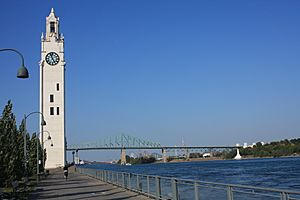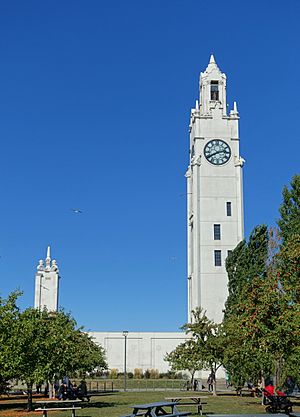Montreal Clock Tower facts for kids
| French: Tour de l'Horloge de Montréal | |

The tower and Jacques Cartier Bridge
|
|
| Coordinates | 45°30′44.44″N 073°32′44.84″W / 45.5123444°N 73.5457889°W |
|---|---|
| Location | Old Port of Montreal |
| Height | 45 m (148 ft) |
| Beginning date | October 31, 1919 |
| Completion date | 1922 |
| Dedicated to | Canadian sailors who died in World War I |
The Montreal Clock Tower (French: Tour de l'Horloge de Montréal) is a famous landmark in Montreal, Canada. It is also known as the Sailor's Memorial Clock. You can find it in the Old Port of Montreal, a historic area of the city.
Building the tower started in 1919 and finished in 1922. It stands about 45 meters (148 feet) tall. To reach the top, you need to climb 192 steps! Along the way, there are three spots to stop and enjoy the view. The outside walls of the tower are white.
The Clock Tower has a main tall section and a smaller tower next to it. The smaller tower is about 12 meters (39 feet) tall. A white wall, about 13 meters (42 feet) long, connects the two towers. The main tower has four large clock faces. Each clock face is about 3.7 meters (12 feet) wide. An English company called Gillett & Johnston designed these clocks.
The Montreal Harbor Commission oversaw the tower's construction. This group was created in 1830 to help develop the Old Port of Montreal. The tower was built to honor sailors who died in the First World War. It also shows how important the port was for sending grain from Montreal to other places.
Contents
The Clock Tower's Story
Building the Montreal Clock Tower took three years, from 1919 to 1922. In 1919, Edward, who was then the Prince of Wales, helped start the construction. He laid the very first stone for the tower's foundation.
The tower was designed by a Montreal engineer named Paul Leclaire. The special clock parts inside were made by Gillett & Johnston. This company also designed the famous clock mechanism for Big Ben in London! Gillett & Johnston made over 14,000 clock mechanisms in their factory in England. The Montreal Clock Tower's mechanism was one of them. Four gears work together to make all four clock faces show the same time.
The Old Port Society now owns the tower. This group helps manage tourism in the area. In 1980, they turned the Clock Tower into a place where visitors can learn about its history. The Old Port Society spent $2.5 million to restore the tower in 1984. This included painting the steel parts and adding a new air system.
Why the Clock Tower is Special
A Historic Landmark
The Montreal Clock Tower is a very important building. In 1996, it was named a Classified Federal Heritage Building. This means it's recognized for its beauty, history, and how it fits into the area. The tower is a key landmark in Montreal. It played a big part in the redevelopment of the Old Port in the 1990s. You can find the tower across from Clock Tower Beach. This beach is a nice place to relax, even though you can't swim there.
A Look into the Past
The Clock Tower is historically important because of the Old Port of Montreal's role in shipping. During the tower's construction, the port was the second busiest in North America for shipping grain. This trade helped Montreal's economy grow a lot. The Old Port was also a major entry and exit point for sailors during the First World War. The tower was built to remember those brave sailors who lost their lives.
Beautiful Architecture
The Montreal Clock Tower is admired for its beautiful Beaux-Arts style. This style focuses on showing nature's beauty through fine art and detailed designs. The tower's shape and decorations fit this style perfectly.
The tower was built using a method called light masonry. This means each part, like the main tower and the smaller tower, was built separately. Then, they were all joined together. This made the tower light but strong. It could stand safely on the wharf where it was built.
The Clock Tower is made of concrete and sits on a square base. The entrance is on the east side. There's also a memorial plaque on the north side. This plaque honors the sailors who died in the First World War. The tower's design includes columns and decorative eagles at each corner. An observation deck is located in the upper part of the tower.
Keeping the Clock Tower Running
The Montreal Clock Tower needs regular care to keep its clock working perfectly. A professional clockmaker, Daniel Pelletier, is in charge of this. He makes sure the clock mechanism is in good shape and that the time is always correct. Mr. Pelletier started working on the tower in 1986 when the clock broke down.
Twice a year, in spring and autumn, he manually adjusts the time for daylight saving time. He moves the gears to change the hands on each clock. The pendulum, which helps the clock mechanism move, needs a lot of attention. It often breaks more than five times a year!
The clock's parts need constant care because of Montreal's changing weather. Hot summers and cold winters can affect the mechanism. Also, many tourists visit the tower, which can cause dust to build up. This means more cleaning and maintenance are needed. Experts say that checking the clock mechanism and the lights behind the clock faces is very important. This helps preserve the tower's heritage.
The outside of the Clock Tower also needs regular maintenance. This helps keep its beautiful look. This includes caring for the trees behind the connecting wall. It also means painting the exterior walls and protecting the memorial plaque. In 2002, the Old Port of Montreal did major work on the tower. They installed a new ventilation system and painted the exposed steel parts.
Visiting the Clock Tower
The Montreal Clock Tower became a tourist center in 1984 after its restoration. The Old Port Corporation manages tourism for the entire Old Port of Montreal area. They have won several awards for making the Old Port a great place to visit.
| Year | Award | Description |
|---|---|---|
| 2006 | Zagat-Survey | Named the most popular tourist destination in Montreal |
| 2005 | Grand Prix du Tourisme Quebecois | Chantale Moisan, a tourism worker, won "Tourism worker of the year" for the Montreal region |
| 2000 | Provincial Winner | The Old Port of Montreal won an "Attraction Canada" award |
See also
 In Spanish: Torre del Reloj de Montreal para niños
In Spanish: Torre del Reloj de Montreal para niños



